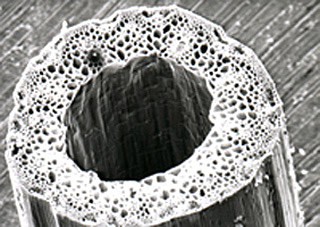
Many plant stems have a circular cross-section with a structure made of a dense outer shell surrounding an inner layer of low density, foam-like cells. (Photo by Prof. Lorna Gibson.)
Instructor(s)
Lorna Gibson
MIT Course Number
3.A26
As Taught In
Fall 2005
Level
Undergraduate
Course Description
Course Features
Course Description
Are you interested in investigating how nature engineers itself? How engineers copy the shapes found in nature ("biomimetics")? This Freshman Seminar investigates why similar shapes occur in so many natural things and how physics changes the shape of nature. Why are things in nature shaped the way they are? How do birds fly? Why do bird nests look the way they do? How do woodpeckers peck? Why can't trees grow taller than they are? Why is grass skinny and hollow? What is the wood science behind musical instruments? Questions such as these are the subject of biomimetic research and they have been the focus of investigation in this course for the past three years.
Other Versions
Other OCW Versions
Archived versions: ![]()


